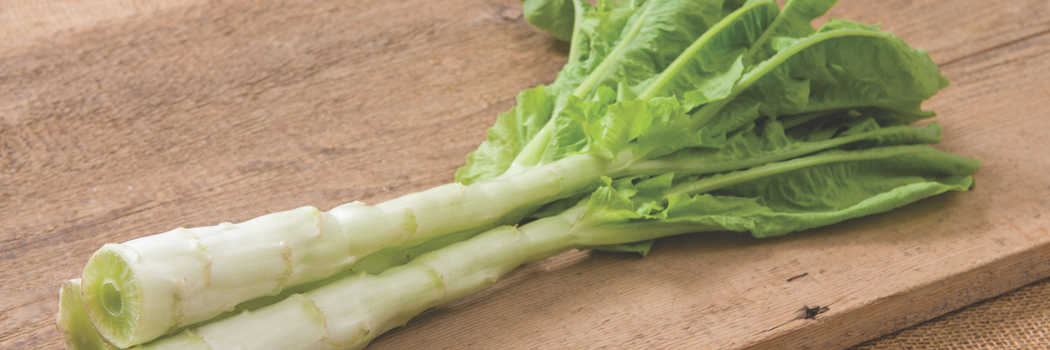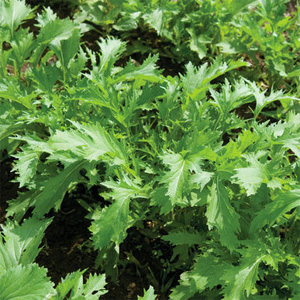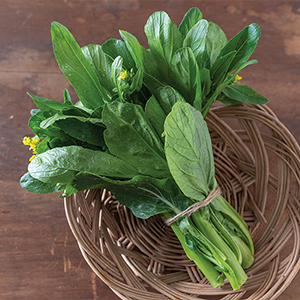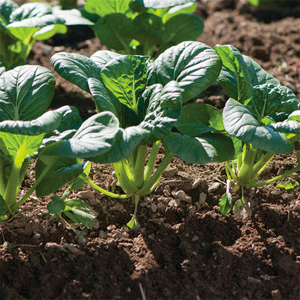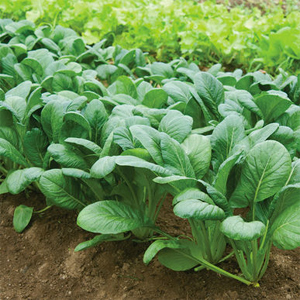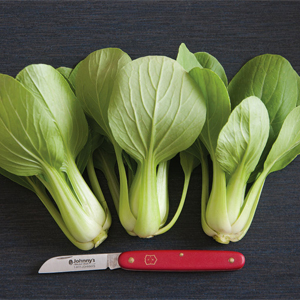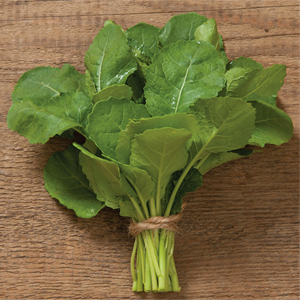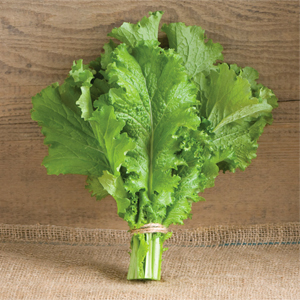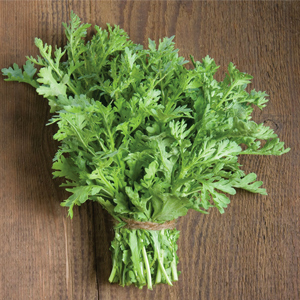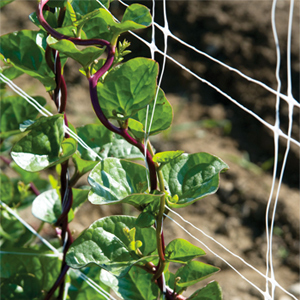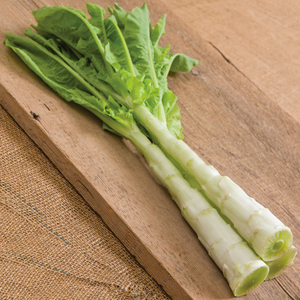- Magenta Spreen | Key Growing Information
- Mustard Greens | Key Growing Information
- Vegetable Amaranth | Key Growing Information
- Mâche/Cornsalad | Key Growing Information
- Video: High-Value Crops & Varieties for Your Garden • Tutorial with Niki Jabbour
- Growing Salad Gardens: An Ultimate Guide by Niki Jabbour | Johnny's Webinar Series
- Pac Choi (Bok Choy) | Key Growing Information
- Orach (French Spinach) | Key Growing Information
- Arugula | Key Growing Information
- Cress Greens: Watercress & Upland Cress | Key Growing Information
- Asian Greens | Key Growing Information
- Malabar Spinach | Key Growing Information
- Baby Leaf Greens: 12 Picks for Market Growers | Johnny's Educational Webinar Resources
- Jang Seeder: How to Maximize Its Potential | Johnny's Educational Webinar Resources
- Baby Leaf Greens & Baby Leaf Lettuce | Technical Production Guide
- How to Grow Arugula • From Seed to Harvest
- Salad Mixes | Key Growing Information
- 'Moonshadow' Purple Ethiopian Kale for Baby-Leaf Greens
- Purslane (Portulaca oleracea sativa) | Key Growing Information
- Lettuce & Greens for Southern Growers | Johnny's Educational Webinar Resources
- Greens for All Growers | A 3-Tiered Approach to Production & Marketing
- Video: Beat the Heat: Lettuce & Greens for Southern Growers | Johnny's Webinar Series
- Claytonia | Key Growing Information
- Webinar Slide Deck | Lettuce & Greens for Southern Growers | PDF
- Salad Mixes & Microgreens Mixes | 2-pp Spec Sheet (PDF)
- Pac Choi Varieties (Bok Choy) | Comparison Chart (PDF)
- Growing Salad Gardens: An Ultimate Guide by Niki Jabbour | Johnny's Webinar Series
- Video: Baby Leaf Harvester for Greens, Mesclun, Spinach, Lettuces & Tender Aromatics
- Winter Growing Guide | Part 6: Recommended Crops & Varieties
- Sorrel | Key Growing Information
- Baby-Leaf Brassica Greens | Key Growing Information
- Celtuce | Key Growing Information
- Asian Greens | 10 Varieties + 5 Easy Recipes from Johnny's Selected Seeds
Johnny's Asian Greens—Beyond Salad Mix
10 World-Class Asian Greens to Grow—Plus 5 Easy Recipes
On This Page
- Mizuna
Recipe • Stir-Fried Mizuna - 'Green D 70 Improved' Choi Sum
Recipe • Stir-Fried Choi Sum with Garlic - 'Koji' Tatsoi
- 'Carlton' Komatsuna
- Mini/Baby Pac Choi
- 'Amara' Mustard
- 'Green Wave' Mustard
Recipe • Indian-Style Fried Mustard Greens - 'Shungiku' Edible Chrysanthemum
Recipe • Korean Shungiku Banshan - Malabar Spinach
- 'Spring Tower' Celtuce
Recipe • Stir-Fried Celtuce - Learn More
At Johnny's we take particular pride in our Asian greens assortment. Years ago we noted a dearth of seed for growing Asian vegetables on this side of the Pacific. We began traveling to Asia to source seed for vegetables which at the time, to many, seemed exotic. Over the years we have continued our journey to develop a comprehensive assortment, to provide both home cooks and professional chefs with just about any green they may desire. To ensure top-notch seed quality, we established relationships with only the best suppliers, both domestic and Asian.
Our palates have gone global since then, but these greens can still be difficult to find in many areas—despite being prized by elite chefs and home cooks alike for their beauty, culinary versatility, and above all, unique flavor. Asian greens are also fast-growing, easy to grow, phytonutrient-rich and, for the most part, easy to prepare. All good reasons to grow your own.
To encourage your further explorations in the garden and the kitchen, we highlight just 10 common and not-so-common Asian greens from our assortment here, plus 5 simple recipes you can prepare in just minutes. (Note that although we won't be focusing on salad mix here, many of these varieties are used for that purpose. We also tucked 'Amara' in here, which originated in Africa but is well-suited to Asian cuisine.)
As expected, these greens are commonly used in stir-fries and soups, but can be braised, grilled, steamed, roasted, and used in countless other ways. Of the many wonders of Asian cooking—whether Thai, Cambodian, Korean, Chinese, Japanese, Indian, Pakistani, or other regional Asian cuisine—the predominance of vegetable dishes is noteworthy. Furthermore, the vegetables share the plate or even take center stage, relative to the protein. Explore these diverse and heathful cuisines on the internet or your favorite cookbook. Don't be afraid to experiment and use your imagination!
1 • Mizuna
This standard salad mix variety is wonderful in stir-fries, fried rice, and soups at full-leaf size. It has a very mild flavor and is quite tender, so it has a very short cooking time.
Stir-Fried Mizuna
This simple recipe showcases the mild flavor of the mizuna, and makes an excellent side dish.
Ingredients
- 1 bunch Mizuna (approximately 12oz / ¾ lb), cut into 2–4" pieces
- 1 Tablespoon oil (we like peanut, grapeseed, or coconut)
- Salt, soy sauce, tamari, or Bragg's coconut aminos to taste
Instructions
- Heat wok or skillet over high heat for 1 minute, then add oil.
- Add Mizuna and cook for 1–2 minutes, until just tender but not overcooked.
- Season to taste with soy sauce or salt and serve.
Note: The Mizuna also may be steamed for a few minutes rather than stir-frying.
2 • 'Green 70 D Improved' Choi Sum
Choi sum is one of the most popular vegetables in Hong Kong, Taiwan, and China, but is not typically seen outside of Asian grocers in the US. This is unfortunate, as choi sum is tender and mildly sweet, and excellent in stir-fries and soups. Harvest just before or once a few buds have opened. Multiple harvests are possible.
Stir-Fried Choi Sum with Garlic
Ingredients
- 1 lb choi sum, cut into 2–3" pieces
- 1 Tablespoon oil (peanut, grapeseed, or coconut)
- 2 large cloves garlic, sliced or minced
- 1 Tablespoon soy sauce, tamari, or Bragg's coconut aminos
- 1 Tablespoon water
Instructions
- Bring a pot of water to a boil, add the choi sum and cook until just tender, about 45 seconds.
- Drain and set aside.
- Heat wok or skillet over high heat for 1 minute, then add oil.
- Add garlic and stir-fry until it starts to brown.
- Add soy sauce and water and cook for 1 minute.
- Add choi sum, stir, and serve.
3 • 'Koji' (F1) Tatsoi
This hybrid tatsoi is more attractive and uniform than open-pollinated tatsoi. It is wonderful in stir-fries and salads. It has an excellent, rich flavor, and its shiny dark-green leaves are very attractive. Named after Koji Uehara, who helped the Boston Red Sox win the World Series in 2013.
4 • 'Carlton' (F1) Komatsuna
Also known as Japanese spinach greens, komatsuna has dark-green, highly flavored leaves. Use in soups and stir-fries, or substitute it for Chinese cabbage for a more highly flavored version of kimchee.
5 • Mini/Baby Pac Choi
'Li Ren Choi' and 'Little Shanghai' are both true baby Pac Choi; the heads are proportional and nicely filled out at the baby size. These diminutive Johnny's staff favorites make for quick kitchen prep; they can be used whole or in halves on the grill, sautéed, braised, or stir-fried. Plant 2–4" apart to produce small, 3–4" pac choi.
6 • 'Amara' Mustard
This nutritious, dark-green mustard of African origin is technically a mustard, but is also known as Ethiopian kale, highland kale, Abyssinian mustard, and Texsel greens. In Ethiopia it is cooked with onions and spices to create a delicious side dish. Many recipes on the internet call for kale or collards, as they are more readily available, but feel free to use 'Amara' instead. Also great in Asian soups.
7 • 'Green Wave' Mustard
This variety is quite spicy when raw, but retains just a little heat upon cooking. Prepare as an Indian side dish, or in Asian stir-fries or soups. It also is a traditional staple food in the American South. All you need to do is boil or steam it in a pot until tender with a little salt and pepper. For a more flavorful option, steam it until half-cooked, then sauté until finished.
Indian-Style Fried Mustard Greens
Ingredients
- 1 lb shredded mustard greens (green cabbage can be substituted)
- 2 large cloves garlic, coarsely chopped or sliced
- 1 Tablespoon coriander powder
- ½ teaspoon mustard seeds
- ½ teaspoon ground fenugreek
- 1 teaspoon cumin seeds
- 1 teaspoon turmeric
- 1 teaspoon (or to taste or omitted) hot pepper flakes
- ½ teaspoon salt, or to taste
- 2 Tablespoons oil (peanut, grapeseed, or coconut)
- Water, as needed
Instructions
- Heat wok or skillet over high heat for 1 minute, then add oil.
- Add garlic and cook until it just starts to brown.
- Add all of the spices and stir for about 30 seconds.
- Add ¼ cup water to the spices and mix.
- Add cabbage and cook until it reaches desired tenderness, adding water by the tablespoon if it becomes too dry.
Note: This is a very flexible recipe. Some cook the mustard just a few minutes for a crisper version, while others cook it longer until it becomes tender. You can vary the quantities of spices or omit any that do not suit your taste.
8 • 'Shungiku' Edible Chrysanthemum
Also known as Garland Chrysanthemum, Shungiku has a unique aroma and intriguing flavor like no other green. Begin harvesting leaves when the plants are 4–8" tall. The plants will produce for several weeks. Cut and bunch entire plants for retail sales. Shungiku is excellent in salads and pickles as well as many cooked dishes.
Korean Shungiku Banchan (side dish)
At a typical Korean restaurant, meals come with several—sometimes over a dozen—of these side dishes, known in Korean as banchan. Kimchee is always one of them.
Ingredients
- 1 bunch shungiku (approximately 12oz / ¾ lb)
- 1 Tablespoon black (best) or white sesame seeds, toasted
- 2 teaspoons sesame seed oil
- ¼ teaspoon salt, or to taste
Instructions
- Steam or boil shungiku until tender.
- Drain, chop into 1–2" pieces, then transfer to a bowl.
- Heat a small pan (cast iron works best), add the sesame seeds, and cook over high heat until they begin to pop.
- Immediately add sesame seeds to shungiku. The seeds will quickly burn if left in the pan.
- Add sesame oil and salt, and mix well.
- Serve warm or at room temperature.
9 • Malabar Spinach
This heat-loving, vining plant that needs to be trellised. It grows slowly in cool spring weather, but quite fast once the weather becomes warm. Malabar spinach has a mild flavor and is used in Indian soups and curries, but can also be included in stir-fries, or, more sparingly, in salads. (For those who do not care for the leaves' somewhat mucilaginous texture when raw, try them cooked—it is far less pronounced once cooked.)
10 • 'Spring Tower' Celtuce
Botanically speaking, celtuce, which originated in China, is lettuce that has been bred to have an enlarged stalk. It has a pleasant, mildly bitter flavor in spring and fall. In the summer it becomes more bitter but not unpleasantly so unless the weather has been quite hot. Use in Chinese stir-fries or eat raw.
Stir-Fried Celtuce
Ingredients
- 2 cups celtuce, julienned
- 1" piece fresh ginger, peeled and minced
- ¼ teaspoon (or to taste) hot pepper flakes
- Salt, to taste
- 1 Tablespoon oil (canola, peanut, soybean, grapeseed, or coconut)
Instructions
- Peel the thick skin of the celtuce and julienne it.
- Bring a pot of water to a boil, add the celtuce and cook until just tender, about 1 minute.
- Drain and set aside.
- Heat wok or skillet over high heat for 1 minute, then add oil.
- Add garlic, ginger, and pepper to the wok and stir-fry until ginger and garlic just start to brown.
- Add celtuce and salt, cook for another minute, and serve.
More About Asian Vegetables
These 10 Asian greens are but a sampling of the many Asian vegetables and herbs you will find at Johnny's. If you've never grown Asian greens, don't wait another season to try a few of these specialty varieties in your garden and kitchen. And if you're already an aficionado, consider dedicating additional space to trialing a new variety or two. You may also be inspired to grow our Asian broccoli, radishes, squash, cabbages, cucumbers, beans, turnip, and eggplant, as well as basil, shiso, lemon grass, and other Asian herbs. You will find their inimitable beauty and flavor easily merit a place at the table.
Learn More
- Asian Greens • Key Growing Information
- Celtuce • Key Growing Information
- Pac Choi (Bok Choy) • Key Growing Information
- Pac Choi (Bok Choy) Comparison Chart • PDF
- Mustard • Key Growing Information
- Malabar Spinach • Key Growing Information
- Greens for All Growers • A 3-Tiered Marketing Approach • Article


